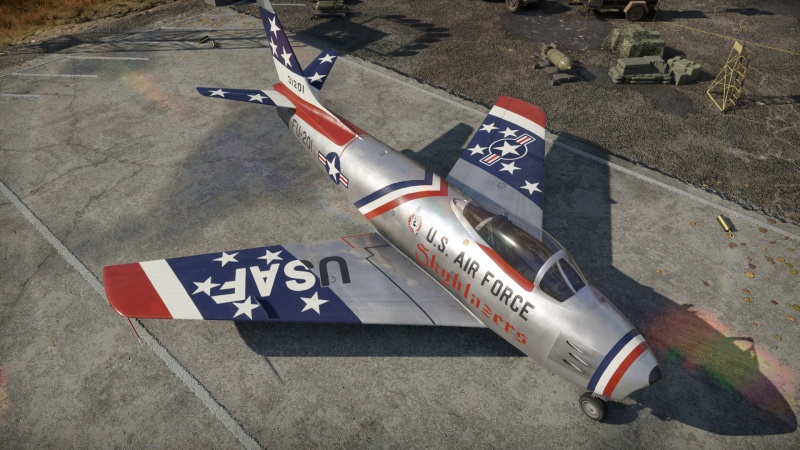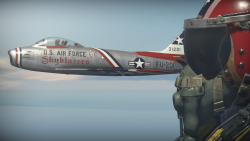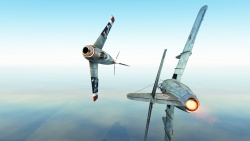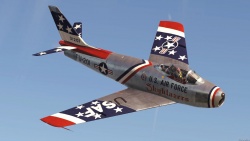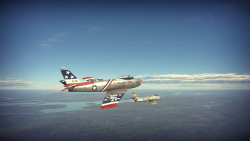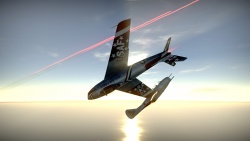Difference between revisions of "F-86F-35"
m (→Details) |
Sporkmonster (talk | contribs) m (i may be wrong but from alot of my tests it seems to be faster than its counterparts at its battle reating. please note i was not trying to mess up the page i was just attempting to make the summary a little more clear) |
||
| Line 19: | Line 19: | ||
{{Specs-Avia-Flight}} | {{Specs-Avia-Flight}} | ||
<!-- ''Describe how the aircraft behaves in the air. Speed, manoeuvrability, acceleration and allowable loads - these are the most important characteristics of the vehicle.'' --> | <!-- ''Describe how the aircraft behaves in the air. Speed, manoeuvrability, acceleration and allowable loads - these are the most important characteristics of the vehicle.'' --> | ||
| − | The {{PAGENAME}} boasts of | + | The {{PAGENAME}} boasts of an excelent speed compared to its other counterparts, at least until the [[Shenyang F-5]], [[MiG-17AS]] and [[Hunter FGA.9]] were released as premium vehicles. This aircraft was one of the first Premium jets available for sale, therefore it is unable to carry either air-to-air or air-to-ground missiles. Retaking on speed, this aircraft is quite fast in a straight line but loses a lot of energy and speed especially when facing a turn. Therefore, if in a pursuit, a precise shot with the [[M3 Browning (12.7 mm)]], can wreak havoc on an enemy aircraft. However, these machine guns aren't so powerful in the jet age when compared to 20 mm cannons, emphasizing the importance of firing accurately and making every shot count. |
This Sabre fighter is an aircraft with a very special camouflage which identifies it as one of the U.S. Air Force Skyblazers, a USAF acrobatic team. The aircraft then is great in manoeuvres at high speed, which makes it a good aircraft for air combat. You can also use it as well for ground attack if managing the 12 [[HVAR]] rockets it can carry. The only drawback to this manoeuvrability is that you lose quite a lot of speed in a turn. As well, the acceleration isn't great and makes the climb rate inferior to one of the other premium jets or other aircraft in its battle rating. | This Sabre fighter is an aircraft with a very special camouflage which identifies it as one of the U.S. Air Force Skyblazers, a USAF acrobatic team. The aircraft then is great in manoeuvres at high speed, which makes it a good aircraft for air combat. You can also use it as well for ground attack if managing the 12 [[HVAR]] rockets it can carry. The only drawback to this manoeuvrability is that you lose quite a lot of speed in a turn. As well, the acceleration isn't great and makes the climb rate inferior to one of the other premium jets or other aircraft in its battle rating. | ||
Revision as of 14:33, 22 February 2021
| This page is about the aircraft F-86F-35. For other uses, see F-86 (Family). |
Contents
Description
The F-86F-35 Sabre is a premium gift rank V American jet fighter with a battle rating of 7.3 (AB), 8.3 (RB), and 9.0 (SB). It was introduced in Update 1.85 "Supersonic".
General info
Flight performance
The F-86F-35 boasts of an excelent speed compared to its other counterparts, at least until the Shenyang F-5, MiG-17AS and Hunter FGA.9 were released as premium vehicles. This aircraft was one of the first Premium jets available for sale, therefore it is unable to carry either air-to-air or air-to-ground missiles. Retaking on speed, this aircraft is quite fast in a straight line but loses a lot of energy and speed especially when facing a turn. Therefore, if in a pursuit, a precise shot with the M3 Browning (12.7 mm), can wreak havoc on an enemy aircraft. However, these machine guns aren't so powerful in the jet age when compared to 20 mm cannons, emphasizing the importance of firing accurately and making every shot count.
This Sabre fighter is an aircraft with a very special camouflage which identifies it as one of the U.S. Air Force Skyblazers, a USAF acrobatic team. The aircraft then is great in manoeuvres at high speed, which makes it a good aircraft for air combat. You can also use it as well for ground attack if managing the 12 HVAR rockets it can carry. The only drawback to this manoeuvrability is that you lose quite a lot of speed in a turn. As well, the acceleration isn't great and makes the climb rate inferior to one of the other premium jets or other aircraft in its battle rating.
| Characteristics | Max Speed (km/h at 0 m - sea level) |
Max altitude (metres) |
Turn time (seconds) |
Rate of climb (metres/second) |
Take-off run (metres) | |||
|---|---|---|---|---|---|---|---|---|
| AB | RB | AB | RB | AB | RB | |||
| Stock | 1,095 | 1,089 | 14700 | 24.7 | 25.9 | 38.8 | 35.9 | 750 |
| Upgraded | 1,115 | 1,106 | 23.6 | 24.0 | 56.5 | 46.7 | ||
Details
| Features | |||||
|---|---|---|---|---|---|
| Combat flaps | Take-off flaps | Landing flaps | Air brakes | Arrestor gear | Drogue chute |
| ✓ | ✓ | ✓ | ✓ | X | X |
| Limits | ||||||
|---|---|---|---|---|---|---|
| Wings (km/h) | Gear (km/h) | Flaps (km/h) | Max Static G | |||
| Combat | Take-off | Landing | + | - | ||
| 0 | 350 | 590 | 550 | 350 | ~11 | ~6 |
| Optimal velocities (km/h) | |||
|---|---|---|---|
| Ailerons | Rudder | Elevators | Radiator |
| < 850 | < 600 | < 650 | N/A |
Engine performance
| Engine | Aircraft mass | |||||
|---|---|---|---|---|---|---|
| Engine name | Number | Empty mass | Wing loading (full fuel) | |||
| General Electric J47-GE-27 | 1 | 5,430 kg | 239 kg/m2 | |||
| Engine characteristics | Mass with fuel (no weapons load) | Max Takeoff Weight | ||||
| Weight (each) | Type | 7m fuel | 20m fuel | 26m fuel | ||
| 1,150 kg | Axial-flow turbojet | 5,787 kg | 6,429 kg | 6,726 kg | 9,530 kg | |
| Maximum engine thrust @ 0 m (RB / SB) | Thrust to weight ratio @ 0 m (100%) | |||||
| Condition | 100% | WEP | 7m fuel | 20m fuel | 26m fuel | MTOW |
| Stationary | 2,626 kgf | N/A | 0.45 | 0.41 | 0.39 | 0.28 |
| Optimal | 2,626 kgf (0 km/h) |
N/A | 0.45 | 0.41 | 0.39 | 0.28 |
Survivability and armour
Examine the survivability of the aircraft. Note how vulnerable the structure is and how secure the pilot is, whether the fuel tanks are armoured, etc. Describe the armour, if there is any, and also mention the vulnerability of other critical aircraft systems.
Modifications and economy
Armaments
Offensive armament
The F-86F-35 is armed with:
- 6 x 12.7 mm M3 Browning machine guns, nose-mounted (300 rpg = 1,800 total)
Suspended armament
The F-86F-35 can be outfitted with the following ordnance:
- Without load
- 16 x HVAR rockets
- 2 x 1,000 lb AN-M65A1 Fin M129 bombs (2,000 lb total)
Usage in battles
While the F-86F-35's acceleration and top speed are lacking compared to its contemporaries, the F-86F-35's slats allow the plane to have an outstanding maneuvrability. That said, one must beware of their speed as pulling high maneuvres at high and max speed can put the plane under great stress which leads to the wings falling appart. The outstanding maneuvrability comes at the cost of speed. Pulling hard turns will bleed your air speed. Try to climb up before engaging the enemy to ensure you have enough energy to get out of a sticky situation. Hopefully, there will be a furball underneath you where you would be able to pounce on low-energy fighters with your guns. One advantage the F-86 has over the jets of other nations is the large ammo count of its 6 x 50 cals (1,800) although it would be wise to hit most of your shoots. Try staying above 500 km/h as any slower and you would lose a significant amount of energy in a pro-longed turn.
Pros and cons
Pros:
- Turns well at high speeds
- 6 x M3 Browning machine guns, if aimed well, can wreak havoc on nearly any aircraft
- Good dive characteristics
- High top speed for its B.R.; can outrun the MiG-15
- Decent acceleration
Cons:
- Poor low speed handling characteristics, aggravated by sluggish acceleration
- M3 machine gun high fire rates can quickly use up your ammo belts
- Slower climb rate compared to the MiG-15
- Tends to quickly bleed off airspeed in a sustained turn
History
The F-86 Sabre was designed by North American Aviation Company in the mid-late 1940s as an air superiority fighter, entering service in 1949 with the USAF. In 1950, it was deployed to Korea to combat the communist MiG-15s, and went on to score 560 kills to only 78 losses against the MiGs. Post-Korea, it went on to serve many other nations such as Pakistan, Taiwan, and Bolivia, the latter nation retiring its Sabres in 1994. Over 9,000 Sabres were built, including versions built in Canada and Australia, making the F-86 the most-produced Western fighter jet in military history.
Media
- Videos
See also
- Related development
- Canadair Sabre CL-13
- North American F-86K Sabre
- North American F-100 Super Sabre
- North American FJ-4 Fury
- Aircraft of comparable role, configuration and era
- Dassault Super Mystère
- Grumman F9F Cougar
- Hawker Hunter
- Lavochkin La-15
- Mikoyan-Gurevich MiG-15
- Mikoyan-Gurevich MiG-17
- Saab J29D Tunnan
External links
| North American Aviation | |
|---|---|
| Fighters | |
| P-51A | P-51 · P-51A |
| P-51C | P-51C-10 |
| P-51D | P-51D-5 · P-51D-10 · P-51D-20-NA · P-51D-30 |
| P-51H | P-51H-5-NA |
| Twin-engine fighters | F-82E |
| Jet fighters | F-86A-5 · F-86F-2 · F-86F-25 · F-86F-35 · F-100D |
| Strike aircraft | A-36 · PBJ-1H · PBJ-1J |
| FJ-4B · FJ-4B VMF-232 | |
| Bombers | B-25J-1 · B-25J-20 |
| Export/Licence | ▂B-25J-30 · ␗B-25J-30 |
| ▄Mustang Mk IA · F-6C-10-NA · ␗P-51C-11-NT · ␗P-51D-20 · J26 David · J26 · P-51D-20-NA · ␗P-51K | |
| F-86F-30 ▅ · ␗F-86F-30 · F-86F-40 ▅ · F-86F-40 JASDF▅ · ␗F-86F-40 | |
| ◄F-86K · ▄F-86K (Italy) · ▄F-86K (France) | |
| ␗F-100A · ▄F-100D · ␗F-100F | |
| Captured | ▅P-51C-11-NT |
| Canadair Limited license-built the F-86 as the CL-13 for use in Canada and export to Europe. | |
| Fiat license-built the F-86K for the Italian Air Force though another 120 NAA built F-86Ks were also sold to the Italians. | |
| See Also | Mitsubishi Heavy Industries · Canadair Limited · Fiat Aviation |
| USA jet aircraft | |
|---|---|
| Fighters | |
| F9F | F9F-2 · F9F-5 · F9F-8 |
| F-80 | F-80A-5 · F-80C-10 |
| F-84 | F-84B-26 · F-84F · F-84G-21-RE |
| F-86 | F-86A-5 · F-86F-25 · F-86F-2 · F-86F-35 |
| F-89 | F-89B · F-89D |
| F-100 | F-100D |
| F-104 | F-104A · F-104C |
| F-4 | F-4C Phantom II · F-4E Phantom II · F-4J Phantom II · F-4S Phantom II |
| F-5 | F-5A · F-5C · F-5E · F-20A |
| F-8 | F8U-2 · F-8E |
| F-14 | F-14A Early · ▄F-14A IRIAF · F-14B |
| F-15 | F-15A · F-15C MSIP II · F-15E |
| F-16 | F-16A · F-16A ADF · F-16C |
| Other | P-59A · F2H-2 · F3D-1 · F3H-2 · F4D-1 · F11F-1 |
| Strike Aircraft | |
| FJ-4 | FJ-4B · FJ-4B VMF-232 |
| A-4 | A-4B · A-4E Early |
| A-7 | A-7D · A-7E · A-7K |
| AV-8 | AV-8A · AV-8C · AV-8B Plus · AV-8B (NA) |
| A-10 | A-10A · A-10A Late · A-10C |
| F-111 | F-111A · F-111F |
| Other | A-6E TRAM · F-105D · F-117 |
| Bombers | |
| B-57 | B-57A · B-57B |
| USA premium aircraft | |
|---|---|
| Fighters | Thach's F2A-1 · Galer's F3F-2 · F2G-1 · F4U-4B VMF-214 · P-26A-34 · Rasmussen's P-36A · P-40C · P-43A-1 |
| P-47M-1-RE · ⋠P-47M-1-RE · P-51A · P-51D-10 · P-51D-20-NA · ␠Kingcobra · XP-55 | |
| ▃A6M2 · ▃Ki-43-II · ▃Ki-61-Ib · ▃Bf 109 F-4 · ▃Fw 190 A-8 · ▃Spitfire LF Mk IXc | |
| Twin-engine fighters | XP-38G · Bong's P-38J-15 · P-38K · YP-38 · P-61A-11 · XF5F · XP-50 · F7F-3 |
| Jet fighters | P-59A · F-86F-35 · F-89B · F-89D · F-4S Phantom II · F-5C · F-20A |
| Strike aircraft | A-1H · A2D-1 · AU-1 · XA-38 · AV-8A · AV-8B (NA) · A-6E TRAM · A-10A |
| Bombers | A-26C-45DT · B-10B · BTD-1 · PBM-3 "Mariner" · PBM-5A "Mariner" · PV-2D |



